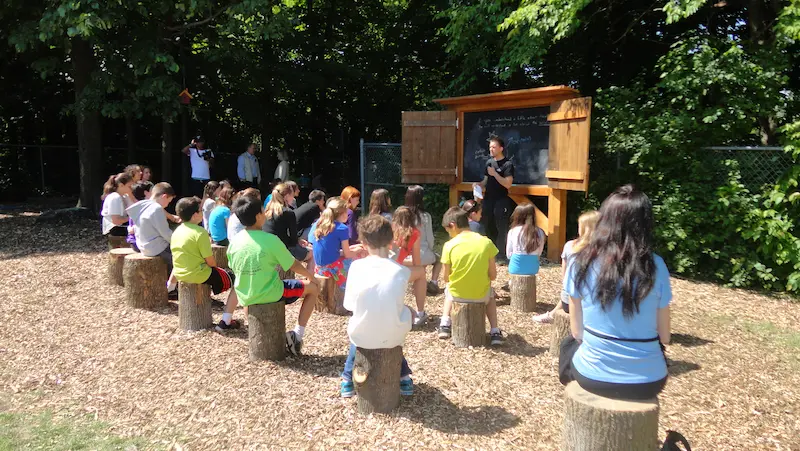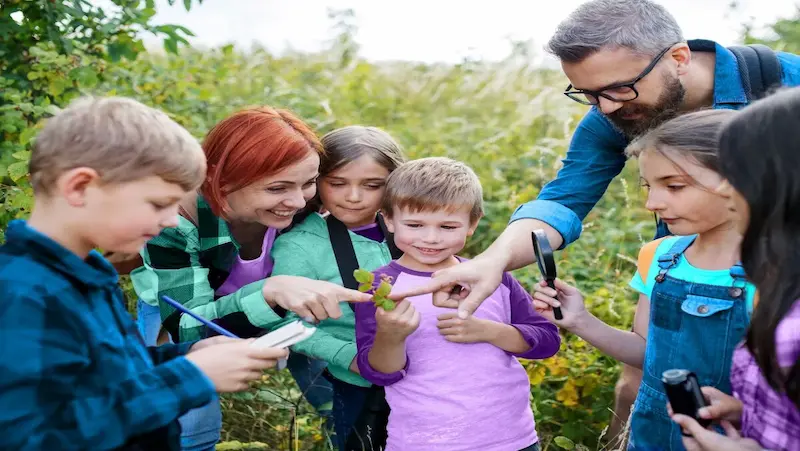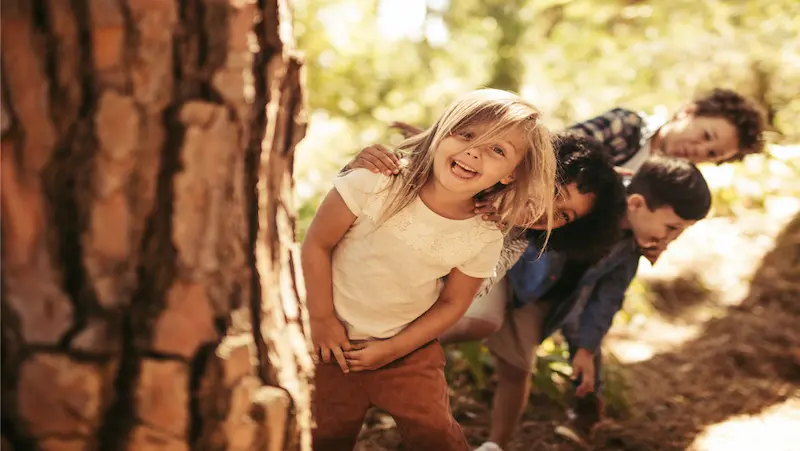Welcome to a journey where classrooms extend beyond four walls and textbooks are replaced by the rich tapestry of the great outdoors. In this exploration, we uncover the profound significance of nature-based learning—a pathway that beckons us to step outside and embrace the world as our classroom.
Nature-based learning is more than just an educational approach; it’s a return to the roots of discovery. It acknowledges that our connection with the natural world is not only essential but also a potent catalyst for holistic growth. In the pages that follow, we’ll unravel the layers of this transformative experience and understand why, in the symphony of learning, nature plays a melody that resonates with the very essence of our being. So, let’s set the stage and delve into the enchanting realm of nature-based learning, where every leaf, rock, and breeze holds a lesson waiting to be learned.
Table of contents
Getting Started

Understanding Nature-Based Learning
Welcome to the exciting journey of nature-based learning! Before we dive in, let’s take a moment to appreciate the wonders of learning that occur in the great outdoors. Nature-based learning is not just about sitting in a classroom; it’s about embracing the world around us as our ultimate classroom.
Think of it as a hands-on experience where the lessons aren’t confined by four walls. Instead, the rustling leaves, the chirping birds, and the vast landscapes become your educational companions. Nature-based learning taps into the innate curiosity we all possess, allowing us to explore and understand the world in a more holistic way.
As you embark on this adventure, open your senses to the environment. Feel the soil beneath your fingers, listen to the wind whispering through the trees, and observe the intricate dance of insects. Nature has its own language, and by immersing yourself in it, you’ll discover a profound connection with the world around you.
Identifying Your Goals and Objectives
Now that you’ve embraced the concept of nature-based learning, let’s shift our focus to your personal goals and objectives. What do you hope to achieve through this journey? Are you seeking a deeper understanding of ecology, aiming to enhance your creativity, or simply looking for a break from the hustle and bustle of everyday life?
Take a moment to reflect on your aspirations. Nature-based learning is incredibly versatile, catering to a wide range of goals. Whether you’re an educator wanting to bring a breath of fresh air into your teaching methods or an individual yearning for a new perspective, clarifying your objectives will guide your path.
Consider jotting down your goals. Are you looking to foster environmental stewardship, improve your well-being, or cultivate a sense of wonder in others? The beauty of nature-based learning lies in its adaptability to various aims. By defining your goals, you pave the way for a more intentional and fulfilling experience.
Practical Implementation

Outdoor Classroom Setup
When it comes to bringing the classroom outdoors, it’s not just about desks and chairs under the open sky. Creating an outdoor games for kids classroom is all about fostering an environment where nature becomes the ultimate teacher. Start simple by arranging seating in a circle using logs or mats. Let the natural surroundings be your walls and the sky your ceiling.
Consider hanging a small whiteboard or a large piece of cardboard on a nearby tree for impromptu lessons and brainstorming sessions. Bring along cushions or blankets to make the outdoor space comfy and inviting. Remember, the goal is to seamlessly blend the structured learning games for kidsenvironment with the untamed beauty of nature.
Invest in some portable shade options like umbrellas or pop-up tents to shield students from the sun. And don’t forget the essentials – a picnic table for group activities for kids, a bird feeder to attract some feathery friends, and a weather-resistant storage box for educational games for kids materials.
Incorporating Nature into Lesson Plans
Nature isn’t just an escape from the traditional classroom; it’s a vibrant and dynamic teaching tool. As you plan your lessons, think about how you can weave the great outdoors into your curriculum.
For science for kids classes, explore the local flora and fauna, turning a simple walk into a botanical expedition. Bring along magnifying glasses for a closer look at leaves and insects. In literature classes, why not have your students read under the shade of a tree, allowing the rustling leaves to serve as their background music?
For math, use pebbles, sticks, or leaves for counting and basic operations. History lessons could come to life with stories for kids about the land you stand on – who walked these trails before you, and what tales do the trees whisper?
Nature Walks and Field Trips
Sometimes, the best lessons happen when you step outside the confines of the traditional classroom. Nature walks and field trips are golden opportunities to let students connect theory with real-world experiences.
Organize a nature walk, encouraging students to observe and document the various plants and animals they encounter. Consider collaborating with local experts or environmental organizations to add depth to the learning experience. Let the outdoors become your living laboratory.
Field trips to parks, botanical gardens, or wildlife reserves can provide a hands-on experience that textbooks simply can’t replicate. Imagine the excitement of a biology class exploring ecosystems or a history class visiting a historical site surrounded by the beauty of nature.
Resources and Support

Collaborating with Environmental Organizations
In our journey towards a greener and more sustainable world, teaming up with environmental organizations becomes a powerful stride. These organizations are like the eco-warriors of the modern era, armed with knowledge, experience, and a passion for the planet. By joining forces, we tap into a wealth of resources that extends far beyond what any individual or small group could achieve.
Picture this: a collaborative effort that intertwines our goals with the expertise of these organizations. It’s like planting a tree together – each root strengthening the other, creating a foundation that can weather any storm. These partnerships bring a diverse range of perspectives, innovative ideas, and the collective strength needed to tackle environmental challenges head-on.
But it’s not just about shared goals; it’s about shared learning. Working hand in hand with environmental organizations opens up opportunities for knowledge exchange. They’ve been on the front lines, learned from successes and setbacks, and have valuable insights that can guide us on our own path. It’s a mutual give-and-take, a dance of ideas that propels us forward in our mission to nurture and protect our planet.
Leveraging Technology for Nature-Based Learning
In this digital age, technology isn’t just about screens and gadgets; it’s a tool that can connect us to the very essence of nature. Nature-based learning, enhanced by technology, is like opening a window to the great outdoors, even if you’re miles away from it.
Imagine a world where a click of a button transports you to a lush rainforest, the serene depths of the ocean, or the expansive landscapes of a national park. Technology allows us to explore, understand, and appreciate the wonders of the natural world in ways that were once unimaginable. It’s like having a personal guide through the intricate ecosystems, helping us comprehend the delicate balance that sustains life on Earth.
From virtual reality experiences that simulate nature walks to online platforms that connect nature enthusiasts worldwide, technology becomes a bridge between us and the environment. It transforms learning into an immersive adventure, making the study of nature not just informative but also captivating.
Overcoming Challenges
Embarking on any adventure comes with its fair share of challenges, and van life is no exception. As you hit the open road, two significant hurdles will undoubtedly cross your path: weather considerations and the ever-watchful eye of safety and regulations.

Weather Considerations
Nature has a way of surprising us when we least expect it, and when you’re living life on the road, weather becomes a formidable adversary. Whether it’s a sudden downpour or scorching heat, being prepared is key.
Imagine waking up to the sound of rain tapping on your van roof. While it may create a cozy atmosphere inside, it also presents a unique set of challenges. Venturing into the realm of waterproofing becomes a priority. Installing weather-resistant seals, checking for leaks, and having a reliable set of rain gear are all part of the van life experience.
On the flip side, sweltering temperatures can turn your van into a mobile sauna. Investing in proper insulation and ventilation becomes a game-changer. Reflective window covers, roof vents, and perhaps a portable fan can transform a stifling space into a comfortable haven.
Flexibility is your greatest ally in overcoming weather-related challenges. Staying attuned to forecasts, adapting your plans accordingly, and embracing the unpredictability of nature will make your van life journey all the more rewarding.
Safety and Regulations
The thrill of the open road is accompanied by the responsibility of adhering to safety measures and regulations. Just like any other mode of transportation, van life comes with its own set of rules to ensure a secure journey for both you and others on the road.
First and foremost, familiarize yourself with the traffic laws and regulations of the areas you’ll be traversing. Different regions may have unique rules, and being in the know can save you from unexpected surprises.
Ensuring your van is roadworthy is not just a matter of compliance but a matter of safety. Regular maintenance checks, tire inspections, and brake assessments should be part of your routine. A well-maintained vehicle is not only more reliable but also safer for you and those sharing the road.
Parking regulations also demand your attention. While the allure of setting up camp in picturesque locations is undeniable, understanding where it’s legal to park overnight is crucial. Many places have designated areas for overnight stays, and respecting these guidelines ensures a hassle-free experience.
Assessing and Measuring Progress

Student Engagement and Learning Outcomes
Imagine a classroom where students are not just attending but actively participating, their eyes sparkling with curiosity, and their minds eagerly absorbing knowledge like sponges. That’s the magic of student engagement. It’s not just about filling seats; it’s about filling minds.
Assessing student engagement is like peering into a treasure chest of enthusiasm. Do they ask questions? Do they collaborate with their peers? Are they excited about what they’re learning? These are the clues that help educators gauge the effectiveness of their teaching methods.
Now, let’s talk learning outcomes – the destination of this educational journey. It’s not just about reaching the end; it’s about what you’ve gained along the way. Are students mastering the concepts? Can they apply what they’ve learned? These are the signposts that tell us if the educational ship is sailing in the right direction.
Collecting Feedback and Making Improvements
In any journey, a navigator relies on feedback to recalibrate the course. The same goes for education. Collecting feedback is like getting input from the passengers on the ship. What did they enjoy? What could be better? This information is pure gold for educators.
Feedback isn’t just about the final destination; it’s about the entire voyage. Regular assessments, quizzes, and even casual conversations with students can provide valuable insights. It’s not a one-size-fits-all approach; it’s a personalized map that helps educators tailor their teaching to the unique needs of their students.
But feedback isn’t a one-way street. It’s a conversation. Educators need to listen, understand, and adapt. It’s the secret sauce for continuous improvement. Just like a chef tweaking a recipe based on feedback, teachers refine their methods to create an even more enriching learning experience.
Conclusion
In the end, the enduring influence of nature-based learning is undeniable. It’s more than just a trend; it’s a transformative force shaping our understanding of education. As we immerse ourselves in the natural world, we discover that the lessons learned extend far beyond textbooks. Nature doesn’t just teach us about the environment; it imparts essential life skills like resilience, curiosity, and a deep appreciation for the world around us. This form of learning is not just a phase—it’s a profound shift in how we view education, leaving an indelible mark on generations to come.
To get your hands on more such articles, educational content, and free resources on coding classes for kids, online robotics classes for kids, game development, etc., check out the BrightCHAMPS Page now!
Frequently Asked Questions
A1: Nature-based learning is an educational approach that incorporates the natural world into the classroom to enhance students’ understanding and engagement with the environment.
A2: You can integrate nature-based learning by incorporating outdoor activities, field trips, and nature-focused lessons that align with your curriculum.
A3: Nature-based learning can enhance students’ curiosity, creativity, and environmental awareness while fostering a love for the outdoors.
A4: Yes, there are many resources, including lesson plans, books, and online communities, that can assist you in implementing nature-based learning.
A5: You can adapt nature-based learning activities for limited outdoor space by using indoor plants, nature-themed projects, and virtual field trips.
A6: Nature-based learning can be tailored for all age groups, from preschool to high school, with age-appropriate activities and content.


 We are an army of educators and passionate learners from BrightChamps family, committed to providing free learning resources to kids, parents & students.
We are an army of educators and passionate learners from BrightChamps family, committed to providing free learning resources to kids, parents & students.












